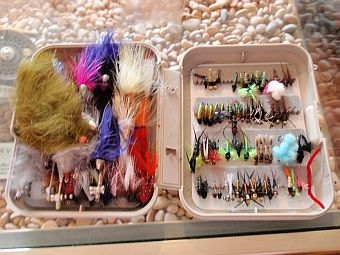Today, we get an update to the incredible Louis Paeth--the painter of the Fish and Feel Fit painting--penned by his son Peter. It's a great story that keeps getting better. You can read the first article by clicking here.
Louis Paeth: An Update
by Peter Paeth
(All illustrations are copyright the Paeth Collection).
After your January blog entry for “Fish and Feel Fit,” I was contacted by Bernie Schultz who sold me a reproduction of a South Bend counter display of “Fish and Feel Fit” he had in his possession. It’s quite impressive and I was pleased to add it to my collection. Thanks again for the exposure your blog afforded me; I’m still hoping that one of your Fishing for History readers may yet aid me with locating and verifying other of Louis A. Paeth’s illustrations and paintings.
As the new year began, further research enabled me to date the “Fish and Feel Fit” illustration to the latter part of 1926 or the early part of 1927. I’m enclosing two scans of South Bend’s advertisements, which originally appeared in Boys’ Life, now digitized on Google books. As far as I can determine, the “Fish and Feel Fit” man first appears on the cover of this 1927 edition of the South Bend fishing book, What Baits & When, being advertised in the March 1927 copy of Boys’ Life.
 March 1926 Boys Life magazine.
March 1926 Boys Life magazine.
 March 1927 Boys Life magazine.
March 1927 Boys Life magazine.
I also want to share with you some recent finds in regards to my father’s early art and illustrative career in Chicago. I have been studying the history of The Milwaukee Road Railroad’s 1926 Gallatin Gateway route to Yellowstone Park, looking for evidence of my father’s work in the abundance of advertising material the railroad created to promote its new park entrance, and its Gallatin Gateway Inn, that was subsequently built the next year.
 The Milwaukee Road advertises the Gallatin Gateway route to Yellowstone Park.
The Milwaukee Road advertises the Gallatin Gateway route to Yellowstone Park.
The presence of some unsigned Milwaukee advertising in my father’s illustrative collection had made me suspect that Louis had done some work for the railroad. This February, while looking through the milwaukeeroadarchives.com website (that features Milwaukee Road illustrated advertising booklets and pamphlets), I found a signed Louis A. Paeth cover illustration for the Milwaukee’s 1930 Northern Wisconsin and Upper Michigan travel brochure.
 Louis A. Paeth art on the front of the CMSP&P Railroad pamphlet.
Louis A. Paeth art on the front of the CMSP&P Railroad pamphlet.
In the illustration, a fisherman is walking towards a lake as the setting sun casts its red light on the rippling water. The artist’s monogram in the lower right-hand corner is similar to one Louis used occasionally on some earlier works—a stylized “P” with an “L” at ten o’clock and an “A” at two o’clock. After examining so many unsigned illustrations, what a surprise!
The red setting sun motif of the illustration was also familiar: in the collection of my father’s artwork, I’ve often noticed this template incorporated into other illustrations. As a practical matter, surely the commercial artist of that day, in order to produce the substantial amount of artwork required, had to return to certain stock themes, much as the jazz musician begins with accustomed riffs while soloing.
 Rising sun in red motif on 1928 Great Lakes Aircraft catalog and 1931 Watkins catalog.
Rising sun in red motif on 1928 Great Lakes Aircraft catalog and 1931 Watkins catalog.
The discovery of Louis’ participation in the Milwaukee Road’s 1930 brochure brought me to the Road’s promotional activities for the fishing and outdoor recreational possibilities of Northern Wisconsin. The Milwaukee, shortly before World War I, had started to run an extra seasonal train during the summer that transported passengers from Chicago to the Northern Wisconsin resorts--first billed as the Fisherman’s Special, eventually shortened to The Fisherman. The train’s 6:25 p.m. departure from Chicago assured an early arrival the next morning at a fishing resort in the Northern Wisconsin area of “big pine woods and many waters.” The Milwaukee Road even sold non-resident Wisconsin fishing licenses at its downtown Chicago ticket offices, thus eliminating the need for its fishing passengers to find a licensing outlet as they arrived to their destination lake.
 May 17, 1930 Chicago Tribune ad.
May 17, 1930 Chicago Tribune ad.
The Milwaukee’s advertisements also encouraged the sportsman’s family to make the trip. An unattributed June 5, 1928 Chicago Tribune illustration I unearthed shows a contented family at lakeshore.
 1928 Chicago Tribune advertisement.
1928 Chicago Tribune advertisement.
This illustration is not only in the same thematic key as an earlier illustration Louis had drawn for the book Safe Counsel (Slide 5, upper left), but stylistically identical.
 1925 Safe Counsel illustration by Paeth.
1925 Safe Counsel illustration by Paeth.
In both, the whole family unit (as in the background of the original proof of “Fish and Feel Fit” itself, pictured at the end of this article) is enjoying the great outdoors: mother contented with shoreline activities, daughter occupied with sand pail and shovel, dad headed out to fish the lake, all happily recreating in the Northern Wisconsin woods made accessible by the Milwaukee’s overnight train, The Fisherman.
 Unattributed Chicago Tribune drawing by Paeth.
Unattributed Chicago Tribune drawing by Paeth.
 Family in the background of the famous painting.
Family in the background of the famous painting.
Imagine the joy and comfort of riding this train: father could leave his downtown Loop office at 5 p.m. and be seated in the diner as The Fisherman pulled out of Union Station. After a sumptuous dinner, a trip to the lounge car would be in order, for discussion of the next day’s fishing prospects with one’s companions, accompanied by a good cigar, and perhaps a discreet sip or two from a hip flask—(Prohibition still enforced as the law of the land).
Somewhere west of Milwaukee, he would retire to his sleeping car berth, and as the train left the mainline at New Lisbon, Wisconsin, heading north up the Wisconsin River branch line towards Wausau and Tomahawk, he slept soundly as the whistling engine of the crack flyer cut through the night (Slide 6). At first light the following morning, before pulling into Minoqua or Star Lake, the dining car staff made sure the fishermen onboard were “all breakfasted and ready for the first cast.”
 Night train illustration by Louis Paeth.
Night train illustration by Louis Paeth.
Unfortunately, even then, the automobile was beginning to change this once-glorious world of passenger train travel, and decreasing train ridership would toll the death knell of this train. The Fisherman would be suspended for a period of time during World War II, and the train finally ceased operations in 1948. But in 1930, what a enjoyable way to travel out of Chicago and what a relaxing way to begin one’s angling vacation in Northern Wisconsin.
 Louis J. Paeth, outdoor illustrator.
Louis J. Paeth, outdoor illustrator.
Often as I search through that era’s illustrative works, I’m transported back to the age of steam trains and bucolic fishing scenes. My reverie of the pleasures of taking this overnight train to a Northern Wisconsin fishing resort brings to mind an oft-quoted line from Norman Maclean’s own classic tale of ‘30s fishing, A River Runs Through It:
“…what a wonderful world it once was.”
Yes…it was.
-- Peter Paeth
What a fantastic article. I can't thank Peter enough for sharing this information, and since I grew up in the Northern Wisconsin woods, this was a truly welcome piece. Hopefully Peter will share the results of his ongoing research with us in the future.


































